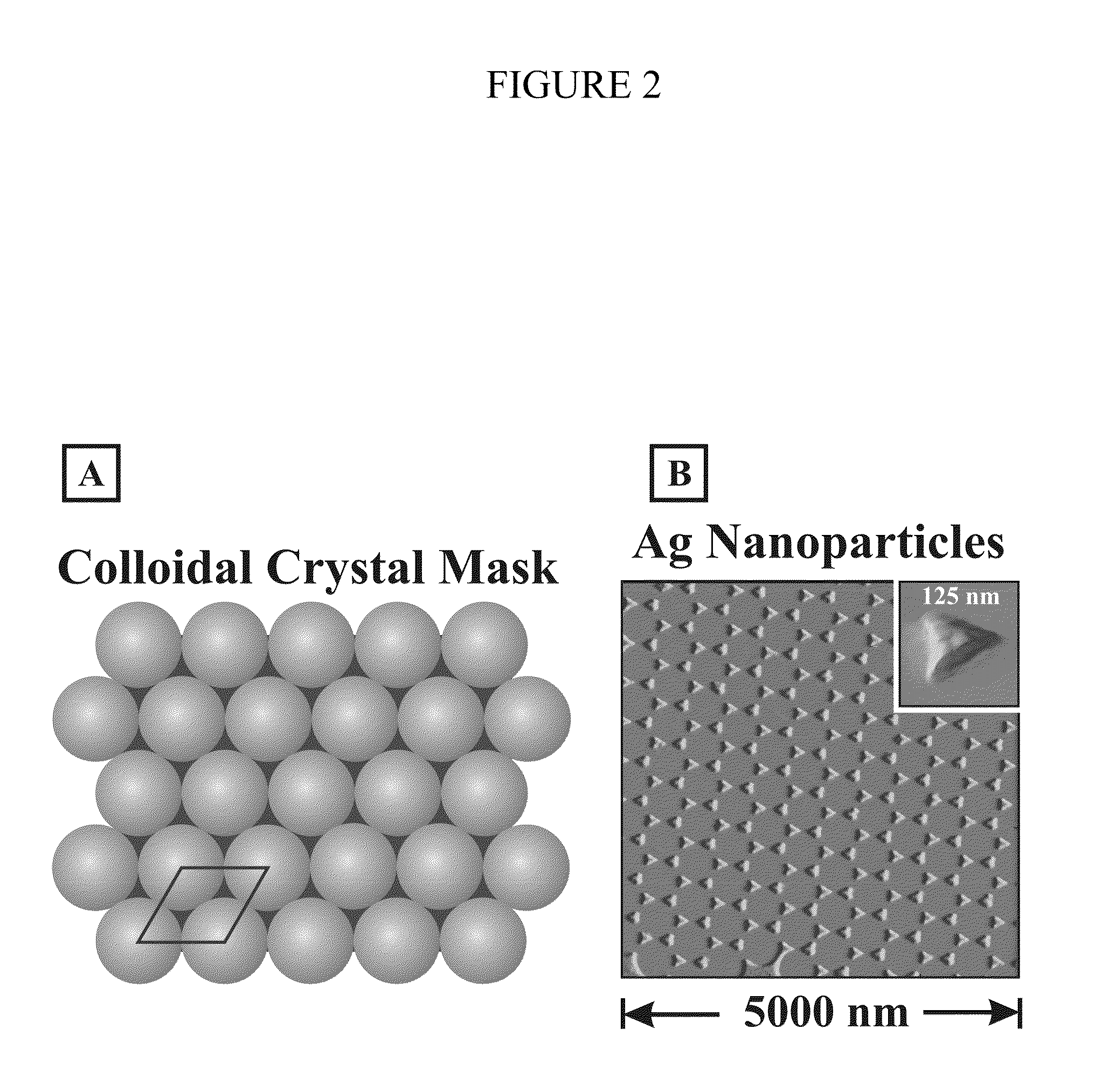Surface-enhanced raman nanobiosensor
a biosensor and surface technology, applied in the field of biosensors, can solve the problems of large fluctuations in glucose levels, inability to adequately monitor glucose levels of patients, and pain in the measurement method
- Summary
- Abstract
- Description
- Claims
- Application Information
AI Technical Summary
Benefits of technology
Problems solved by technology
Method used
Image
Examples
example 1
Optimization of SAMs for Biosensors
[0118]This Example describes the characterization of glucose sensing biosensors comprising a variety of SAMs.
A. Materials
[0119]Ag (99.99%, 0.04″ diameter) was purchased from D. F. Goldsmith (Evanston, Ill.). Glass substrates were 18 mm diameter, No. 2 coverslips from Fisher Scientific (Fairlawn, Va.). Pretreatment of substrates required H2SO4, H2O2, and NH4OH, all purchased from Fisher Scientific (Fairlawn, Va.). Surfactant-free white carboxyl-substituted polystyrene latex nanospheres with diameters of 390±19.5 nm were obtained from Duke Scientific Corporation (Palo Alto, Calif.). Tungsten vapor deposition boats were purchased from R. D. Mathis (Long Beach, Calif.). 4-aminothiophenol (90%), L-cysteine (97%), 3-mercaptoproprionic acid (99+%), 11-mercaptoundecanoic acid (95%), 1-hexanethiol (95%), 1-octanethiol (98%), 1-DT (96%), 1-hexadecanethiol (92%), 3-mercapto-1-propanesulfonic acid (Na+ salt, 90%), benzenethiol (99+%), cyclohexylmercaptan (97%)...
example 2
Biosensors Utilizing EG3 Monolayers
[0130]This Example describes the characterization of glucose-sensing biosensors comprising EG3 self assembled monolayers.
A. Methods
Materials
[0131]All the chemicals were of reagent grade or better, and used as purchased. Ag wire (99.99%, 0.04 inch diameter) was purchased from D. F. Goldsmith (Evanston, Ill.). Oxygen-free high conductivity copper was obtained from McMaster-Carr (Chicago, Ill.) and cut into 18-mm-diameter discs. CH3CH2OH, H2O2, and NH4OH were purchased from Fisher Scientific (Fairlawn, Va.). Surfactant-free white carboxyl-substituted latex polystyrene nanosphere suspensions (390±19.5 nm diameter, 4% solid) were acquired from Duke Scientific Corporation (Palo Alto, Calif.). Tungsten vapor deposition boats were purchased from R. D. Mathis (Long Beach, Calif.). For substrate and solution preparations, ultrapure water (18.2 MΩcm-1) from a Millipore academic system (Marlborough, Mass.) was used. Bovine serum albumin and saline were obtaine...
example 3
In vivo Glucose Analysis
[0141]In some embodiments, an in vivo animal system is used to test the nanobiosensors of the present invention. A SERS biosensor (e.g., a fiber optic glucose sensor) is quantified in 10 Sprague-Dawley rats. Diabetes is induced with a single injection of streptozotocin (35 mg / kg) given IP. The blood glucose levels of each rat are measured daily using blood drawn from the dorsal tail vein until a diabetic state is confirmed by glucose measurements over 200 mg / dL.
[0142]In order to implant the sensors, the rats are anesthetized with 50 mg / kg sodium pentobarbital given IP. Every hour, or earlier if the rat responds to external stimuli, an additional dose (⅕ of the original dose) is given. The hair on the abdomen of the animal is removed with an electric razor following assurance that the animal does not feel pain. The skin is then scrubbed with a tamed iodine soap. Subsequent to sterilization of the skin surface, an approximately 10 mm long incision is made in th...
PUM
 Login to View More
Login to View More Abstract
Description
Claims
Application Information
 Login to View More
Login to View More - R&D
- Intellectual Property
- Life Sciences
- Materials
- Tech Scout
- Unparalleled Data Quality
- Higher Quality Content
- 60% Fewer Hallucinations
Browse by: Latest US Patents, China's latest patents, Technical Efficacy Thesaurus, Application Domain, Technology Topic, Popular Technical Reports.
© 2025 PatSnap. All rights reserved.Legal|Privacy policy|Modern Slavery Act Transparency Statement|Sitemap|About US| Contact US: help@patsnap.com



